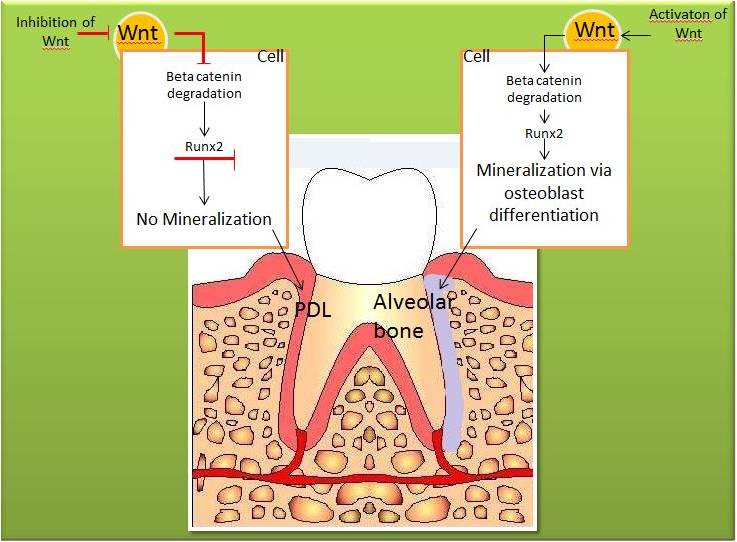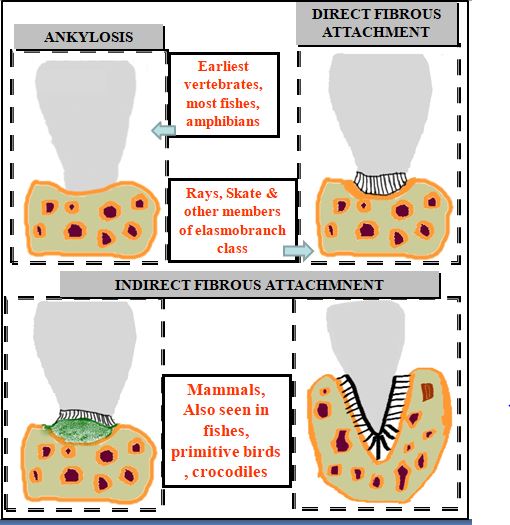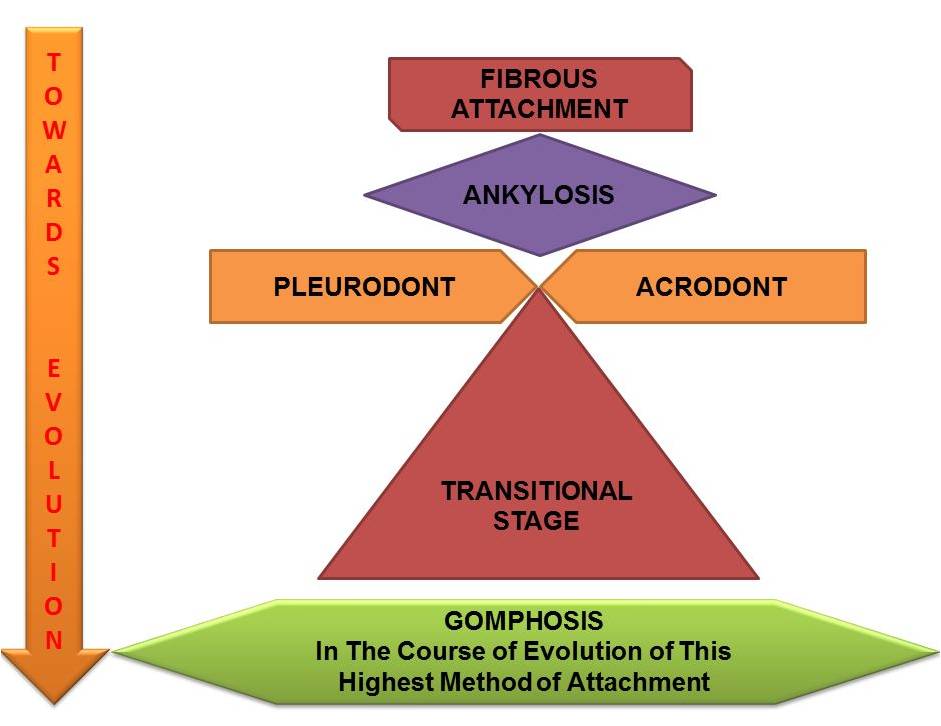
Journal of Clinical Images and Medical Case Reports
ISSN 2766-7820
Case Report - Open Access, Volume 2
Evolution of periodontal attachment apparatus - Fossils to final forms
Bhatnagar Anurag1; Kharidi Laxman Vandana2*
1 Department of Periodontology, Faculty of Dental Sciences, SGT University, Room no. 2, Gurugram, Haryana-122001, India.
2 Senior Professor, Department of Periodontics, College of Dental Sciences, Davangere, Karnataka- 577004, India.
*Corresponding Author: Kharidi Laxman Vandana
Senior Professor, Department of Periodontics, College
of Dental Sciences, Davanagere - 577004, Karnataka,
India.
Email: vanrajs@gmail.com
Received : Oct 16, 2021
Accepted : Dec 07, 2021
Published : Dec 14, 2021
Archived : www.jcimcr.org
Copyright : © Vandana KL (2021).
Abstract
The study of tooth attachment evolution establishes relationship between living & extinct forms of life which provides useful evidence for general affinities between related species. Human dentition, established very early in evolution, and has persisted with little change from its evolutionary vertebrates. Evidences have proven a sure link between the human periodontal apparatus and other vertebral animals that have been used to simulate human oral anatomy. The intention of attempting this review is based on the role of animal models used for experimentation prior to human clinical trials. There are few papers dealing with animal models suitable to periodontal research laboratory. Hence an attempt has been made to briefly present the evolution of tooth attachment based on comprehensive of available minimal literature. The current paper deals with evolution through natural selection, evolution of humans, attachment apparatus and tooth attachment have been presented comprehensively.
Keywords: evolution; attachment apparatus; periodontal ligament; periodontal evolution.
Citation: Anurag B, Vandana K. Evolution of periodontal attachment apparatus - Fossils to final forms. J Clin Images Med Case Rep. 2021; 2(6): 1475.
Introduction
Evolution is a process of change over a long period that has enabled living things to adapt to different environment. How evolution occurred is a debate among scholars, but it occurrence is a scientific fact. Biologist believes that living things arose through a long history of changes shaped by physical and chemical processes that are still going on.
Various descendant species are evolved as the time passes through and they modified into diverged species. The natural selection and evolution are often fused. Evolution is the changes that occurred through history of inheritance and the mechanism by which it occurred is natural selection. The evolutionary changes are studied through the knowledge of the recorded historical data which includes comparative anatomy, biochemistry, embryology and geographic distribution. These are directly deduced from the examination of fossils and are interpreted from the process of natural selection. The biological diversity has been understood and expanded our knowledge through recent development in molecular technology [1].
The evolutionary process of humans and the attachment apparatus is not been discussed on a routine basis. The knowledge regarding evolution of attachment apparatus of human dentition has been presented in books and journals. There is no elaborative information available so far and there are quite a few gaps in continuity of available information. The intention of attempting this review is based on the role of animal models used for experimentation prior to human clinical trials. These animals that are related closely are best suitable for the animal experimentation. There are few papers dealing with animal models suitable to periodontal research laboratory. However, this review includes evolution of human attachment apparatus which are anatomically related to evolution. Hence an attempt has been made to briefly present the evolution of tooth attachment based on comprehensive available minimal literature. Medline search using keywords reviled few articles related to the topic of evolution and tooth attachment.
The current paper deals with evolution through natural selection, evolution of humans, attachment apparatus and tooth attachment have been presented comprehensively which served as the objective of this review paper.
Evolution through natural selection
The evolutionary changes that led to development of beast and birds had occurred over million years ago (375 million years ago) when a vaguely large salamander-like species invaded the land from its aquatic habitat. The chronicle evolutions of life on this planet have been illustrated by many such viewpoints [2]. Evolutionary processes are considered slow in action. Life on earth is continuous and is induced by environmental changes or by processes within animals. The organisms are derived from their earlier ancestral form into present known organisms. This have been well postulated by the “Theories of Organic Evolutions” as versed by Jean Baptiste Lamarck who proposed the theory of ‘inheritance of acquired characters’ also known as `Lamarckism‘.
Lamarck stated that the changes in the environment have effect on the shape and organization of species. Also the frequency of the use of an organ leads to its development and enlargement, while permanent disuse of organ will weaken it until it disappears. Hence through continuous use and disuse, the environment influences the acquisition or loss of characters which are preserved by reproduction. He proposed many examples; the best understood is ‘Long neck of Giraffes’. For many generations, individual giraffes stretched to reach the uppermost levels of trees. In each generation the giraffes added some length to their necks. It means new organ developed from new needs and it develops in the proportion to the extent they one used. Later this theory was disapproved due to various criticisms [2]. It was proposed that the environment can affect the animal but it’s highly doubtful that a need can form new structures, also this theory didn’t include vital force in organism which increases the body part [2].
On contrary to the popular opinion, the idea of biological evolution that began with Charles Darwin’s foremost work, On the Origin of Species by Means of Natural Selection (1859) was not recognized. Darwin explained that evolution occurs by the differential survival of organisms following their naturally occurring variation process “natural selection”. Although Darwin’s original hypothesis has changed a lot but basic concepts remain the same [3].
Advance studies in genetics and molecular biology have explained the occurrence of the hereditary variations that are important for natural selection, hence supporting Darwin’s theory. Genetic variations result from changes or mutations in the nucleotide sequence of DNA, the molecule that genes are made from. Such changes in DNA now can be detected and described with great precision [3]. The translating code that is used nucleotide sequences translation into amino acid sequencing is same in all living organisms. This is used to reconstruct the gene sequence that determines the evolutionary history of the organisms. A recent concept of evidences supporting evolution is through the sequencing of DNA called “pseudo-genes”. Pseudo-genes are basically remnants of old gene sequences which no longer are in function, but they continue to be present along with working DNA sequence. Pseudo-genes can change throughout the time, as they passes from ancestors to descendants. Therefore they are offer useful in reconstructing the evolutionary relationships between species [4]. The molecular biology and modern biochemistry discoveries have reinforced the evidences that unify the principle of common descendants. These molecular concepts are useful for various purposes. It indicates the time of divergence of species in the past when it got separated from one another and determines the relationship between the evolutionary organisms [3].
Prior to human evolution, the animal kingdom (vertebrates) has to be visited.
Animal kingdom: Vertebrates
Knowledge of working elements like local plants and animals are important to the people who are living close to the nature. They often recognize a large group of organisms like fishes, birds and mammals. However this known knowledge is based on their needs and not based on scientific evidences. A considerable interrelationship exist with ecology, evolution, behavior, genetics and physiology which varies with regard to the biological system classification that uses the terms taxonomy and systematic.
Evolution of human
Human or Homo sapiens are evolved from a distinct family of species called Hominids - The Great Apes that began with the evolution of historical primates of genus Homo and eventually emerged into an anatomically modern humans. Separation of the last common ancestor, chimpanzees forms the first evolved form of humans, characterized by number of changes in the behavioral, developmental, physiological, and morphological [4]. The increase in the brain size, decreased sexual dimorphism (different characteristics of opposite sex of same species), lengthened ontogeny (developmental changes from early life- infants to maturity- gestation) and bipedalism (two leg organisms) are some significant adaptations of the Homo sapienssapiens. The relationship between these changes is the subject of ongoing debate [3]. And such is the development of human oral structures i.e. teeth and periodontium. The attachment apparatus of species showed several of the evolutionary changes.
Attachment apparatus
It consists of that part of the dental unit which attaches the (tooth) root to the alveolus namely: Periodontal ligament, Alveolar bone, Cementum.
In the early stage of vertebrate embryogenesis the lateral ridges are formed from the neural plate that has pluripotent cells called neural crest cell population. The cells disperses and migrates from the dorsum of the neural tube to throughout the embryo giving rise to a wide range of differentiating cells.
The structures of the craniofacial region which includes the cranial skeleton, its connective tissue, cranial ganglion and peripheral nervous system that innervates the region are fundamentally developed from the building blocks called Cranial Neural Crest Cells (CNCC). These cells are important towards formation and development of the mature human dentition [3,5].
Table 1:Histological features of various attachment apparatus which is classified on the basis of comparative histology of periodontal tissues.
|
Proloacrodont |
Acrodont |
Acro-protothecodont |
Pleurodont |
Thecodont |
Period |
440- 450 million year ago |
440 million year ago |
- |
- |
270 million years ago |
Tooth attachment |
Acellular- cellular bone |
Bony or fibrous |
Fibrous with or without bony attachment |
Fibrous or bony attached to inner bony wall |
Fibrous attachment |
Features |
Superficial layer of odontodes |
Attached by collagenous fibers in mineralized connective tissue matrix produced by osteoblast and odontoblast |
Fiber apparatus may or may not attached to intermediate bone |
Teeth are Homodont, Haplodont, Polyphyodont. |
Tooth root consist cementum, periodontal ligament, alveolar bone. |
Example |
Agnathions of Silurian period |
Aganthodi , |
Fishes |
Lizards |
Placental mammals |
Embryologists over the past century have extensively studied the fate of embryonic cells- CNCC which migrates to form future head region. The migratory pathway of CNCC in vertebral embryos has been mapped. The first brachial arch gives rise to axial- specific structures, primary masticatory muscles and the jaw skeleton. Further the first arch of the mammalian vertebrates gives rise to characteristic dentition. The molecular signaling that occurs between CNCC and ectoderm of first arch lead to migration of the tooth generating buds into the embryo. Within the dentition along the dental axis, changes and differences in the shape and size occurred which formed speciesspecific series of tooth structures [3].
Modern molecular signaling pattern in Dorsophila gene wingless (Wnt in mammals) have been considered as an answer for non-mineralized periodontal ligament formation. Illustration of the mechanism of Wnt gene signaling has been shown in Figure1depicting how ankylosed to fibrous attachment can occur [6].
Tooth Attachment Types: Periodontal Differentiation of Teeth Through Phylogeny.
The mammalian periodontal attachment is most complex form of tooth attachment with respect to its structure and function. This highly complex structure developed from early vertebrates at a relatively late stage of evolution.
Degenerative changes and the regenerative potential are different in various types of dentition. Teeth evolved from dermal denticles of the conodont type or odontods are the aganathic chordates which appeared before the dermal armor or toothlike placoid scales seen during Pisces evolution [5,6].
Over the many years the tooth attachment changed from bone-attachment type, seen in most fishes and early reptiles to ligament-tooth attachment, seen in small fishes, like pike, anglefish and hake. No true teeth are present in birds and turtles. In the evolution of true gomphosis which is only seen in mammals, an intermediate form of tooth attachment is observed in crocodilians [6].
Gaengrer and Metzel (1992) have studied the evolutionary pattern of tooth attachment apparatus by means of comparative periodontology and have classified tooth attachment into 5 types: 1) Proloacrodont, 2) Acrodont, 3) Acro-protothecodont, 4) Pleurodont, 5) Thecodont. The time periods, tooth attachment, its features, the animal examples for the same and histological features are shown in Table-1 [5].
Evolution of tooth attachment
Over millions years many modifications took place where the earliest mammals were evolving from reptilian predecessors lead to the development of socketed attachment of teeth. The evolution of periodontium is a story of changes and developmental relationship between tooth and bone. These changes give phylogenic developmental evidences of mammalian periodontal evolution (Figure-2a-d) [5].
The transition from ankylosed tooth form to development of root portion that remains in the bony attachment (Acrodont) and then the early development of fibrous attachments into the bony socket (Pleurodont) to the specialized periodontal ligament development (Thecodont, Gomphosis) are transitional stages that has occurred over 220 million year ago. (Figure-3) [5,6]
Hertwig (1874 and 1879) learned the developmental evolution of gomphosis type of attachment. Gomphosis attachment is seen in all mammals and some socketed fishes and reptiles like crocodiles [5]. Gomphosis-type of periodontal attachment where mineralization of fibers doesn’t occur has been observed with first mammals in 220 million years ago around Triassic era, perhaps as a result of selective pressure from changed eating habits [6]. The variations in the shape, size and position of socket depends upon the masticatory forces transmitted onto the bony wall [4]. Unlike mammals, gomphosis joint changes in reptilia crocodile, where alveolar bone doesn’t remodels according to successive eruption of tooth. Once alveolar bone is formed, it remains same and successive tooth erupts with fibrous attachment to the socket wall. This type of attachment is called thecodont gomphosis (Figure-2c) [5].
The crocodilians features a gomphosis‐type connection between alveolar bone and tooth root compared to the other reptilians which have jawbone-tooth‐root connected by means of ankylosis. Caiman (crocodilian species) periodontium are an intermediary link between the mouse (a mammal) periodontal ligament which is non-mineralized and the Gecko attachment apparatus which is mineralized (means ankylosed type of attachment). Caiman ligament fibers are less organized compared to mammalian mouse ligament fibers. Although Caiman ligament fibers have a distinct fasciae surrounding ligament fibers into bundles, which is similar to mammals. The differences in periodontal ligament fiber organization and mineralized fibers, between non-crocodilian reptiles, crocodilian reptiles, and mammals [7] may reflect an evolutionary link between ankylosis and gomphosis type of periodontal attachment [6,7].
Clinical significance
In selection of experimental animals, events during periodontal health and disease differ from species to species. Laboratory animal model are based on similar characteristics of human anatomy and periodontal disease, so that extrapolation of results of animal experimentation will help the human clinical trials. The altered gene expression is the result of perdurable tissue interactions, quiescent genetic information remaining in genome and the phylognetic memory [5].
Conclusion
The study of tooth attachment evolution, establish relationship between living & extinct forms of life which provides useful evidence for general affinities between related species.
Human dentition established very early in evolution and has persisted with little change although dramatic changes occurred in locomotion, brain size & cranio-facial morphology. The selection for a single type of tooth attachment was obviously an important event in the phylogeny of mammals. The current topic is an intersection of fossils to human life form.
References
- Loso JB. What is Evolution? In: Lenski Richard, editor. How evolution shapes our lives: essays on biology and society, 1st ed. United Kingdom: Princetion University press. 2016; 3-9.
- Burkhardt RW. Lamarck, evolution, and the inheritance of acquired characters. Genetics. 2013; 194: 793-805.
- Cobourne MT, and Mitsiadis T. Neural crest cells and patterning of the mammalian dentition. J Exp Zool B Mol Dev Evol. 2006; 306: 251-260.
- National academy of sciences. Science and Creationism: A view. In: National Academy of Sciences, 2nd ed, Washington DC: The national academies press. 1999.
- Gaengler P, and Metzler E. The periodontal differentiation in the Phylogeny of teeth- an overview. J Periodontal Res. 1992; 27: 214-225.
- Diekwisch TG. Our periodontal tissue: a masterpiece of evolution. J Clin Periodontol. 2016; 43: 320‐322.
- McIntosh James, Anderton Xochitl, Flores-De-Jacoby Lavinia, Carlson David S, Shuler Charles, et al. Caiman Periodontium as an Intermediate between Basal Vertebrate Ankylosis-Type Attachment and Mammalian “True” Periodontium. Microscopy Research and Technique. 2002; 59: 449-459.



